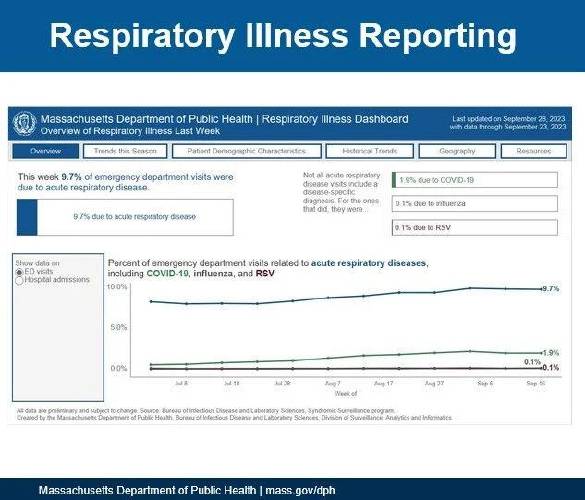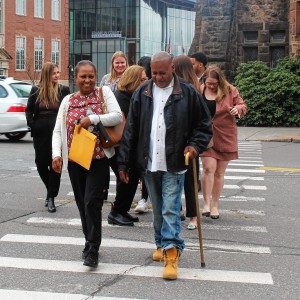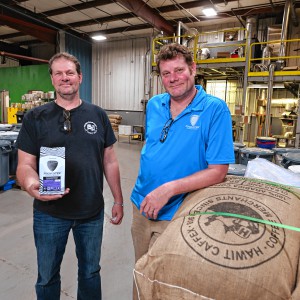Redesigned state dashboard will track respiratory illnesses

A screenshot of the new respiratory illness data dashboard that the Department of Public Health rolled out late last week. Courtesy Image/Massachusetts Department of Public Health
| Published: 10-10-2023 3:57 PM |
BOSTON — With peak season for respiratory illnesses like the flu and COVID-19 approaching, the Department of Public Health has launched a refreshed dashboard to track trends and provide the public with helpful information focused on COVID-19, influenza and respiratory syncytial syndrome (RSV).
The redesigned dashboard, which will continue to be updated weekly by the end of each Thursday, centralizes DPH reporting on respiratory illnesses and attempts to make the most useful or relevant information available at a glance, with users able to drill down for even more detail.
“We’re heading into a winter where COVID-19, influenza and RSV, respiratory syncytial virus, are likely to co-circulate. We all experienced kind of the predominance of COVID for so long, and then last season with the tripledemic, we started to really see kind of what our future might look like,” state epidemiologist Dr. Catherine Brown said. “And it was during that tripledemic where everybody needed information about what was happening with more than just COVID. We needed to look at respiratory diseases more widely.”
The main landing page features graphic snapshots of the data available for each virus, a full listing of available data and links to download raw data files. A page for immunization information is in the works and is expected to launch soon, DPH said.
DPH officials said they hope the redesign will make it easier for people to get surface-level information — like the current risk level for COVID-19 or the share of hospitalizations that stem from one of the respiratory illnesses — while keeping detailed data accessible for people and organizations that want a more granular look.
Brown said that, when it comes to respiratory viruses, “it’s really important to know what’s happening in as close to real time as possible” and that the new dashboard “should enable us to do this.”
“For people who do flu surveillance there’s a saying, which is ‘If you’ve seen one flu season, you’ve seen one flu season,’ sort of suggesting that there’s something unique and the patterns are a little bit different year after year,” she said. “And I think that is probably what we’ll end up seeing with COVID, RSV and flu. It’s going to be a little bit different every single season, but we’re ready to monitor the patterns as they’re happening so that people have the information they need to be able to respond to that activity. And so the department has the information we need to help people respond.”
The responses to COVID-19, the flu and RSV might look different this year. In addition to the annual flu shots and an updated COVID-19 vaccine, Brown said there are new tools to help combat RSV.
Article continues after...
Yesterday's Most Read Articles
 Greenfield homicide victim to be memorialized in Pittsfield
Greenfield homicide victim to be memorialized in Pittsfield
 Former Greenfield man granted new trial after 1995 murder conviction, walks free
Former Greenfield man granted new trial after 1995 murder conviction, walks free
 On The Ridge with Joe Judd: What time should you turkey hunt?
On The Ridge with Joe Judd: What time should you turkey hunt?
 Judge sets bail for Millers Falls assault suspects
Judge sets bail for Millers Falls assault suspects
 Franklin Tech student welds artistic bench for French King Bridge
Franklin Tech student welds artistic bench for French King Bridge
 As I See It: Between Israel and Palestine: Which side should we be on, and why?
As I See It: Between Israel and Palestine: Which side should we be on, and why?
The U.S. Food and Drug Administration approved the first vaccine for RSV in May, clearing it for use in the “prevention of lower respiratory tract disease caused by RSV in individuals 60 years of age and older.” And in August, the FDA approved the use of a monoclonal antibody product for all infants under 8 months and some older babies at increased risk. The U.S. Centers for Disease Control and Prevention said the product “has been shown to reduce the risk of both hospitalizations and health care visits for RSV in infants by about 80%.”
RSV is a highly contagious virus that causes lung and breathing passage infections. Its circulation is seasonal, typically starting in the fall and peaking in the winter. The CDC reports that between 58,000 and 80,000 children under the age of 5, most of them infants, are hospitalized each year due to RSV infection. RSV kills an estimated 100 to 300 children younger than 5 each year, the CDC said.
The shifting nature of respiratory illness season was not the sole reason DPH decided to refresh its data reporting dashboard. After more than three years of either daily or weekly COVID-19 data reporting and numerous seasons producing weekly flu reports from October through May, DPH has “a deeper understanding of how the dashboards are used and the patterns that we see in people accessing them,” Brown said.
When the COVID-19 dashboard first launched in 2020, people were more likely to dig in and spend some time clicking around through its different pages. But that changed fairly quickly, Brown said, and now the majority of people who visit the dashboard pages look only at the first page that pops up so they can get a broad sense of the situation. Meanwhile, local boards of health and other stakeholders are still just as interested in getting their hands on DPH’s full raw data sets each week.
“We needed to make sure that we were trying to satisfy or meet the needs of as many different audiences as possible,” Brown said. “And so that’s one of the reasons for this sort of modular design, where we have these topline indicators — here’s what you need to know if you really don’t care about data and you don’t want to look any further — but then here are some additional options for you to dig into the data further for the much smaller percentage of people who are interested in doing that.”

 Fogbuster Coffee Works, formerly Pierce Brothers, celebrating 30 years in business
Fogbuster Coffee Works, formerly Pierce Brothers, celebrating 30 years in business 1989 homicide victim found in Warwick ID’d through genetic testing, but some mysteries remain
1989 homicide victim found in Warwick ID’d through genetic testing, but some mysteries remain Doors open at Tilton Library’s temporary home at South Deerfield Congregational Church
Doors open at Tilton Library’s temporary home at South Deerfield Congregational Church DA to announce breakthrough in 1989 unsolved homicide in Warwick
DA to announce breakthrough in 1989 unsolved homicide in Warwick
